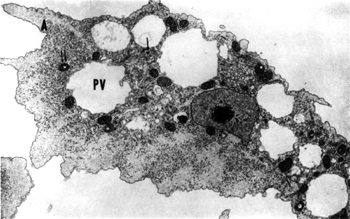


An electron micrograph of amoebae. Amoebae can protect bacteria from
environmental pollutants.

Are there novel sources of microbes useful in the bioremediation of explosives and other toxic wastes?

Arms reduction relative to the cessation of the Cold War refocuses priorities from arms production to weapons destruction. The four major wars as well as the Cold War in this century resulted in arms production in many disparate sites in this country and abroad. Disposal or destruction of these contaminants requires innovative procedures as alternatives to incineration, which is too costly or no longer permitted. The manufacture of special and conventional weapons systems within the Department of Energy complexes produce a variety of chemical products (TNT, RDX, HMX, etc., as well as their metabolites) that require special treatment for disposal. Application of biodegradation and bioremediation techniques may potentially provide the only viable solution.
The exploration of this relatively unexamined microbial niche has resulted in bacterial degradation patents. These bacteria have shown unusual desorbing and degradative capabilities upon interaction with a variety of environmental contaminants, including the destruction of TCE and desorption of mercury from soil. Recently studies have shown that these microbes also can transform or degrade TNT from contaminated soil. Preliminary studies undertaken in conjunction with Explosive Ordinance Disposal Technologies, Inc., (EODT), likewise indicates the degradation of napalm by the microbes. These results indicate the amoebic/bacterial consortium can degrade a variety of recalcitrant contaminants and may be particularly useful in degrading explosives.

Tyndall, R. L., K. S. Ironside, C. D. Little, D. S. Katz and J. R. Kennedy. 1991. Free-living amoebae used to isolate consortia capable of degrading trichloroethylene. Appl. Biochem.Biotechno. 28/29:917-925.
Vass, A. A., C. Ho, R. L. Tyndall. 1995. Application of amoebae associated bacteria in the degradation of explosives. In Proceedings of the American Society of Microbiology, Q-7 (in press).
Integrated Assessment Briefs. 1995. ORNL/M-4227. Oak Ridge National Laboratory, Oak Ridge, TN.